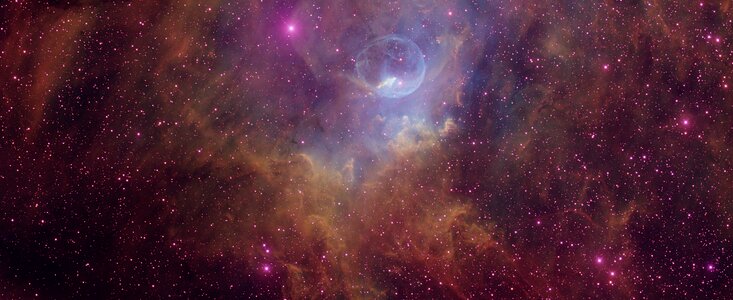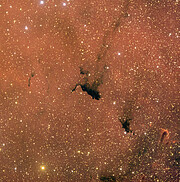New Images of the Bubble Nebula and Barnard 163 from Kitt Peak
7 Enero 2007
The ghostly blue Bubble Nebula and a swan-like dark nebula known as Barnard 163 are featured in beautiful new images taken in 2006 using the Mayall 4-meter telescope at Kitt Peak National Observatory. The newly released images are displayed in large format at the NOAO exhibit booth starting today in Seattle at the 209th meeting of the American Astronomical Society.
The Bubble Nebula (NGC 7635) is one of three shells of gas surrounding the massive star BD+602522, the bright star near the center of the bubble. Energetic radiation from the star ionizes the shell, causing it to glow. About six light-years in diameter, the Bubble Nebula is located in the direction of the constellation Cassiopeia. The magenta wisps near the bottom-right of the image are an unexpected bonus—the wisps are the remnants of a supernova that exploded thousands of years ago. This is the first optical image of the supernova remnant, which was discovered at radio wavelengths by the Canadian Galactic Plane Survey in 2005.
Barnard 163 is a dark nebula within IC 1396, a very large emission nebula complex in the constellation Cepheus. This interstellar cloud was discovered by Edward Emerson (E. E.) Barnard (1857-1923), an American astronomer and pioneer of astrophotography who began as an amateur comet hunter, earned a degree in mathematics and later worked at Lick Observatory and the University of Chicago. He is also the namesake of Barnard’s star, the second closest known star system to Earth.
A third image from the Kitt Peak Mayall telescope taken in 2006 and featured at the NOAO exhibit booth at the AAS meeting, a bright reflection nebula in Orion known as M78, was released earlier this year.
All three of the images were taken using the 64-megapixel Mosaic-1 digital imager on the Mayall 4-meter telescope by Travis A. Rector of the University of Alaska Anchorage and Heidi Schweiker of the National Optical Astronomy Observatory (NOAO) in Tucson, Arizona.
“These images show the quality of observations, the high resolution and the wide field of view that the Mosaic-1 camera regularly achieves on the Mayall telescope,” says Rector. “It is a joy to work with the excellent data that the Mosaic cameras produce, both at Kitt Peak and on the Blanco 4-meter telescope in Chile.”
Notas
All images credit: T.A. Rector/University of Alaska Anchorage, H. Schweiker and NOAO/AURA/NSF
The National Optical Astronomy Observatory, based in Tucson, Arizona, includes Kitt Peak National Observatory near Tucson, Cerro Tololo Inter-American Observatory in Chile, and the NOAO Gemini Science Center. It is operated by the Association of Universities for Research in Astronomy Inc. (AURA), under a cooperative agreement with the National Science Foundation.
Enlaces
The image of M78 is available from the NOAO Image Gallery
Contactos
Douglas Isbell
Office of Public Affairs and Educational OutreachNational Optical Astronomy Observatory
Tel: 520/318-8230
Correo electrónico: disbell@noao.edu
About the Release
| Release No.: | noao0702 |
| Legacy ID: | NOAO 07-02 |
| Nombre: | Barnard 163, Bubble Nebula, NGC 7635 |
| Facility: | Nicholas U. Mayall 4-meter Telescope |
| Instruments: | Mosaic I |




